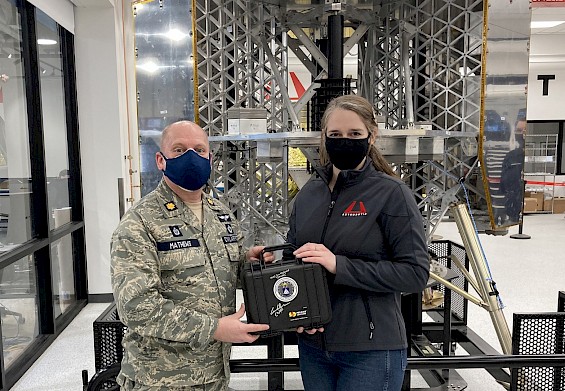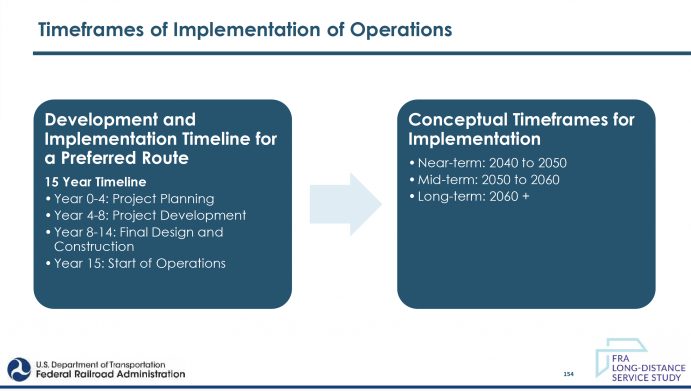Happening Now
Are Moon Shots Easier Than Passenger Rail?
February 23, 2024
By Jim Mathews / President & CEO
This week we learned that it is easier, faster, and cheaper to land on the Moon than it is to deliver new passenger rail service or even to develop and deliver new railcars.
And that’s kind of a depressing lesson to learn.
I follow these sorts of things because they are important elements of public-policy discussion. But I’ll confess I also follow these sorts of things because they’re cool. As a very young boy I had autographed pictures of astronauts on my bedroom wall, and astronaut-suited GI Joes. Even today, I have a personal connection to the privately built Astrobotics Peregrine Moon-landing project (see picture). I was selected to deliver the Civil Air Patrol’s payload chip to Astrobotics in 2021 to be fitted on the ill-fated Peregrine lander.

Peregrine tried and failed last month to do what Intuitive Machines’ Odysseus IM-1 spacecraft did spectacularly last night, successfully landing on the Moon softly and upright with six scientific payloads now preparing to send valuable data back home.
Meanwhile, I just got home Wednesday night from three weeks’ work travel focused mostly on helping a Federal Railroad Administration-led team draw up a vision for more long-distance routes all across the country. It was – and is – exciting and inspiring. (Read more about it here.) But imagine the jarring comparisons running through my head after watching last night's Moon landing.
Fully realized this exciting new rail network will bring passenger rail to 45 million Americans who don’t have it today, double access on tribal lands, nearly double access in rural parts of the United States by adding 102 stops connected to metropolitan statistical areas, ensure that 86 percent of all U.S. medical centers have rail access, and restore service to 13 million people who lost it to various Amtrak cuts. Better yet, our back-of-the-envelope analysis suggests that just diverting about 11 percent of the trips that take place along these routes from cars and planes could eliminate some 893.7 billion tons of carbon emissions every single year, reducing emissions 12 percent per year. Even using the most conservative cost-of-carbon estimates available today that would represent a savings to the economy of $4.5 trillion every year.
That kind of goodness has got to be worth at least as much effort as sensors to examine the plasma environment on the lunar surface and experimental LIDAR guidance systems for future Moon missions? Right?
Well, this is the Rail Passengers’ blog so you know the answer is “Yes.” But the timeline assumed in the long-distance study for getting services going is soberly realistic...which is to say it is depressingly long. Take a look at this slide from the Round Three summary presentation by the FRA-led study team:

The earliest – earliest! – we could see anything result from this work according to the analysis is 2040 to 2050. “Medium-term” goes out to 2060. For projects that will NOT build new greenfield track and will run new trains in places where trains already for the most part run today. Meanwhile, the Intuitive Machines project team only got their marching orders from NASA six years ago, started inventing new kinds of technologies in 2018, and Thursday night put their lander softly onto the Moon’s South Pole...for roughly the cost Amtrak believes it will take to buy 16 new railcars by the year 2035.
We must do better. We just HAVE to do better.
The good news is researchers from both the Eno Center for Transportation and New York University’s Marron Institute say that the problems which underpin the U.S.’s glacial pace of project development and delivery are extremely solvable – if we just think differently about how we manage programs, how public agencies are resourced, and how we assess the true costs of well-meaning litigation which winds up paradoxically making projects cost more while permitting more environmental harm than we avoid with environmental legal challenges.
NYU’s Alon Levy, who maintains the definitive database on worldwide transit construction costs and one of the main authors of Marron’s report, declared that “the causes of high American (especially New York) costs are institutional, and fixable, without a revolutionary upending of the legal or social system.”
A 2022 feature story about Levy’s work in Vice summarizes the findings of their team’s 15 years of work, which finds that the reason it’s harder, slower, and more expensive to develop and deliver rail-based capital projects in the U.S. boils down to:
“Hiring contractors to do the work in a manner so bizarre it almost seems intentionally designed to drive up costs;
Hiring consultants to design and manage projects rather than having the staff to do so in-house (or not having the necessary staff expertise to manage consultants in a way that keeps costs manageable);
Haphazardly coordinating complicated work with local utilities;
Viewing infrastructure projects as job programs and therefore hiring more workers than needed (union and non-union, blue collar and white collar);
Over-designing projects (stations in particular);
And, on top of it all, having local politicians who micro-manage, slowing down planning at best; changing projects in a way that makes them more expensive and less useful at worst.”
Researchers have found and confirmed that it’s NOT union labor, environmental protections, or even geographic challenges that make our projects cost more. Europe has more generous employment laws and tougher environmental standards. Instead, costs in the U.S. for public projects are treated like proprietary secret information rather than taxpayer-borne expenses that should see the light of day. Decades of Reaganesque shrinking of government capacity leaves oversight agencies without the staff or the knowledge to manage contractors effectively. Our Dante-like layers of legal environmental review stretch two or three years of decision into decades and cost millions of dollars while blocking projects which, on balance, would supply a net improvement for the environment by mitigating some of the key drivers of the climate crisis.
“At a high level, the U.S. simply lacks the state capacity to move projects expeditiously,” Levy wrote in 2021. “Environmental review laws, byzantine Buy America and prevailing wage regulations, and the constant threat of litigation all conspire to slow projects to a snail’s pace while causing costs to soar. Meanwhile, the dearth of in-house planning capacity at the state and local level means agencies charged with overseeing projects are not merely unaware of international best practices but would be unable to implement such practices even if they were. Rather than award contracts based on the lowest cost bid, for example, U.S. transit agencies would be better off selecting contracts on the basis of a technical score, and with budgets that are itemized — two approaches that are known to be superior, but which require in-house engineering and project management staff to enact.”
As the NYU team noted when it released its report a couple of years ago, “lower costs can be achieved” even without “large-scale legal changes.” The answer lies in “reassessing decision-making processes, institutions, the nuts and bolts of project agreements, and getting key decision makers to support projects rather than delay difficult decisions.” This last point is especially crucial. Delays cost millions of dollars and doing nothing also carries exorbitant costs.
Which gets me back to Thursday night. I’ve heard this week a lot of criticism from armchair experts ridiculing the FRA-led study effort so far as a “Moon shot.” Well, since NASA and its partner Intuitive Machines managed to make a Moon shot in six years for $118 million, maybe FRA, Amtrak, our state agencies, and all of us advocates should aspire to making a Moon shot for passenger rail. Maybe that would be faster and cheaper.
(I’ve linked to a lot of materials in this piece. You should go check them out for a lot more detail than I can include in a single opinion article. Click on these links below for more.)
NYU Marron Center Transit Projects Database Home
https://transitcosts.com/about/
Eno Transportation On High Construction Costs
https://enotrans.org/article/shining-more-lights-on-a-multi-billion-dollar-problem-high-costs-for-transit-construction/
Vox: “Why does it cost so much to build things in America?”
https://www.vox.com/22534714/rail-roads-infrastructure-costs-america
Intuitive Machines’ IM-1 Odyssey Press Kit
https://www.intuitivemachines.com/_files/ugd/7c27f7_51f84ee63ea744a9b7312d17fefa9606.pdf
Vice: “There's a plan to spend $100 billion fixing the Northeast Corridor by 2035. Similar countries build entire new rail corridors with dozens of new stations for a fraction of that cost. Why can't the U.S.?”
https://www.vice.com/en/article/k7b5mn/a-dollar100-billion-lesson-in-why-building-public-transportation-is-so-expensive-in-the-us
Vice: “Here’s How the US Can Stop Wasting Billions of Dollars on Each Transit Project”
https://www.vice.com/en/article/xgym5j/heres-how-the-us-can-stop-wasting-billions-of-dollars-on-each-transit-project
[Editor’s Note: This opinion piece was completed and posted at 11:30 am Friday. At the time it was posted the most current information was that, according to Dr. Tim Crain, Intuitive Machines’ chief technology officer, data acquired shortly after the landing suggested that his company’s Odysseus lander was vertical and “stable.” On Friday afternoon hours after this piece was posted, Intuitive CEO Steve Altemus reported during a press conference at NASA’s Johnson Space Center that his team now believes the lander might have tipped over on its side after catching one of its feet during the landing. This Association is not a newswire service, and it’s not possible to update every item we post on the blog as it is overtaken by current events. The fundamental point, however, still stands – that Intuitive Machines and its NASA partners were able to conceive, design, develop, build, launch, and land, however imperfectly, a spacecraft on the lunar surface for $118 million in the same span of time that we now accept it takes to move halfway through a passenger-rail project development phase on already-existing right-of-way before even entering final design and construction.]
"It is an honor to be recognized by the Rail Passengers Association for my efforts to strengthen and expand America’s passenger rail. Golden spikes were once used by railroads to mark the completion of important rail projects, so I am truly grateful to receive the Golden Spike Award as a way to mark the end of a career that I’ve spent fighting to invest in our country’s rail system. As Chair of the Transportation and Infrastructure Committee, it has been my priority to bolster funding for Amtrak, increase and expand routes, look to the future by supporting high-speed projects, and improve safety, culminating in $66 billion in new funding in the Bipartisan infrastructure Law."
Representative Peter DeFazio (OR-04)
March 30, 2022, on receiving the Association's Golden Spike Award for his years of dedication and commitment to passenger rail.
Comments